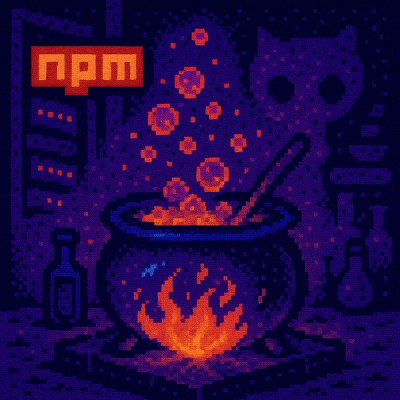
Research
/Security News
9 Malicious NuGet Packages Deliver Time-Delayed Destructive Payloads
Socket researchers discovered nine malicious NuGet packages that use time-delayed payloads to crash applications and corrupt industrial control systems.
@ktarmyshov/digraph-js
Advanced tools
[yet another] A dependency free library to create and traverse directed graphs
Yet another graph module.
Based on the idea of https://github.com/antoine-coulon/digraph-js
Make Directed Graphs traversal and construction effortless, also includes deep circular dependency detection.
DiGraph class takes care of only managing the vertices, edges, and bound bodies to vertices and edges.
const digraph = new DiGraph<Vertex, Edge>();
const vertexA: VertexWithId<Vertex> = { id: 'a', vertex: {} };
const vertexE: VertexWithId<Vertex> = { id: 'e', vertex: {} };
const vertexB: VertexWithId<Vertex> = { id: 'b', vertex: {} };
digraph.addVertices(vertexA, vertexB, vertexE);
digraph.addEdges({ from: vertexE.id, to: vertexA.id });
digraph.getDescendantIds(someId);
digraph.getDescendants(someId);
digraph.getAncestorIds(someId);
digraph.getAncestors(someId);
Traversal functionality is for different traversion over the graph: DFS, BFS, deep descendants, deep ancestors
// BFS
let bfs = GraphTraversal.bfs(graph);
// Traverse over ids of vertices
const ids = bfs.traverseIds();
const ids = bfs.traverseIds({ startVertexId: '1' });
const ids = bfs.traverseIds({ startVertexId: '1', depthLimit: 2 });
// Traverse over nodes as {id, vertex}
const verticesWithIds = bfs.traverse();
const verticesWithIds = bfs.traverse({ startVertexId: '1' });
const verticesWithIds = bfs.traverse({ startVertexId: '1', depthLimit: 2 });
// DFS
let dfs = GraphTraversal.dfs(graph);
// Deep descendants
const childrenIds = DescendantTraversal.getDeepDescendantIds(graph, '1');
const children = DescendantTraversal.getDeepDescendant(graph, '1');
const ancestorsIds = AncestorTraversal.getDeepAncestorIds(graph, '4');
const ancestors = AncestorTraversal.getDeepAncestor(graph, '4');
Functionality for detecting all paths from a given vertex. Supports depthLimit.
Paths that contain cycles include the node that closes the cycle at the end e.g. ['a', 'b', 'c', 'b'].
it('should return all paths from a given vertex, depthLimit = INFINITY', ({ expect }) => {
const graph = new DiGraph<Vertex>();
const vertices = [...createRawVertices('1', '2', '3', '4', '5', '6', '7', '8', '9', '10')];
graph.addVertices(...vertices);
graph.addEdges({ from: '1', to: '2' });
graph.addEdges({ from: '2', to: '3' });
graph.addEdges({ from: '3', to: '4' });
graph.addEdges({ from: '1', to: '5' });
graph.addEdges({ from: '5', to: '6' });
graph.addEdges({ from: '6', to: '7' });
graph.addEdges({ from: '5', to: '8' });
graph.addEdges({ from: '1', to: '9' });
graph.addEdges({ from: '9', to: '10' });
graph.addEdges({ from: '10', to: '4' });
const paths = new GraphPaths(graph);
const result = [...paths.getPathsFrom('1')];
const expected = [
['1', '2', '3', '4'],
['1', '5', '6', '7'],
['1', '5', '8'],
['1', '9', '10', '4']
];
expect(result).toEqual(expected);
});
it('should return all paths from a given vertex, depthLimit = 3', ({ expect }) => {
const graph = new DiGraph<Vertex>();
const vertices = [...createRawVertices('1', '2', '3', '4', '5', '6', '7', '8', '9', '10')];
graph.addVertices(...vertices);
graph.addEdges({ from: '1', to: '2' });
graph.addEdges({ from: '2', to: '3' });
graph.addEdges({ from: '3', to: '4' });
graph.addEdges({ from: '1', to: '5' });
graph.addEdges({ from: '5', to: '6' });
graph.addEdges({ from: '6', to: '7' });
graph.addEdges({ from: '5', to: '8' });
graph.addEdges({ from: '1', to: '9' });
graph.addEdges({ from: '9', to: '10' });
graph.addEdges({ from: '10', to: '4' });
const paths = new GraphPaths(graph);
const result = [...paths.getPathsFrom('1', 2)];
const expected = [
['1', '2', '3'],
['1', '5', '6'],
['1', '5', '8'],
['1', '9', '10']
];
expect(result).toEqual(expected);
});
it('should return all paths from a given vertex, depthLimit = INFINITY, with cycles', ({
expect
}) => {
const graph = new DiGraph<Vertex>();
const vertices = [...createRawVertices('1', '2', '3', '4', '5', '6', '7', '8', '9', '10')];
graph.addVertices(...vertices);
graph.addEdges({ from: '1', to: '2' });
graph.addEdges({ from: '2', to: '3' });
graph.addEdges({ from: '3', to: '4' });
graph.addEdges({ from: '1', to: '5' });
graph.addEdges({ from: '5', to: '6' });
graph.addEdges({ from: '6', to: '7' });
graph.addEdges({ from: '5', to: '8' });
graph.addEdges({ from: '1', to: '9' });
graph.addEdges({ from: '9', to: '10' });
graph.addEdges({ from: '10', to: '4' });
graph.addEdges({ from: '4', to: '1' }); // Adding a cycle
graph.addEdges({ from: '2', to: '1' }); // Adding a cycle
const paths = new GraphPaths(graph);
const result = [...paths.getPathsFrom('1')];
const expected = [
['1', '2', '3', '4', '1'],
['1', '2', '1'],
['1', '5', '6', '7'],
['1', '5', '8'],
['1', '9', '10', '4', '1']
];
expect(result).toEqual(expected);
});
it('should return empty paths from a given vertex, without edges - paths with just one vertex are not emitted', ({
expect
}) => {
const graph = new DiGraph<Vertex>();
const vertices = [...createRawVertices('1', '2', '3', '4', '5', '6', '7', '8', '9', '10')];
graph.addVertices(...vertices);
graph.addEdges({ from: '1', to: '2' });
graph.addEdges({ from: '2', to: '3' });
const paths = new GraphPaths(graph);
const result = [...paths.getPathsFrom('1', 1)];
const expected: string[][] = [['1', '2']];
expect(result).toEqual(expected);
});
Functionality for detecting cycles in the graph.
// Classical DFS graph cycle detection, only one cycle (if any) per node is detected, supports depthLimit
const cycles = new CyclesDFS(graph);
expect(cycles.hasCycles(1)).to.equal(false);
expect(cycles.hasCycles(2)).to.equal(true);
const foundCycles = Array.from(cycles.findCycles(2));
expect(foundCycles).to.deep.equal([['a', 'c']]);
// Johnson's cycle detection, supposedly most performant of existing, does not support depthLimit
// All elementary cycles are detected, multiple cycles per node possible
// https://www.cs.tufts.edu/comp/150GA/homeworks/hw1/Johnson%2075.PDF
// https://epubs.siam.org/doi/10.1137/0205007
const cycles = new CyclesJohnson(digraph);
digraph.addEdges({ from: vertexD.id, to: vertexA.id });
expect(cycles.hasCycles()).to.equal(true);
const foundCycles = Array.from(cycles.findCycles());
expect(foundCycles).to.deep.equal([['a', 'b', 'c', 'd']]);
For sample benchmarking, refer to the webpack cycle detection benchmark script.
To perform benchmarks on a wide graph, we use webpack which is probably one of the largest open source Node.js codebase. ./webpack.json is the file representing the whole webpack graph, built by skott.
Apple M1 Max
Vertices added: 560
Edges added: 2004
----------------------------------------
Started webpack benchmark with cycle detection = INFINITY (Johnson)
Has cycles: true
Cycles found: 127988
Duration (seconds): 9.648516041999999
Duplicates: 0
Unique cycles: 127988
Longest cycle: 33
----------------------------------------
Started webpack benchmark with cycle detection = INFINITY (DFS)
Has cycles: true
Cycles found: 164
Duration (seconds): 0.001205959000000803
Duplicates: 0
Unique cycles: 164
Longest cycle: 16
----------------------------------------
Started webpack benchmark with cycle detection = 500
Has cycles: true
Cycles found: 164
Duration (seconds): 0.0009284170000009908
Duplicates: 0
Unique cycles: 164
Longest cycle: 16
----------------------------------------
Started webpack benchmark with cycle detection = 100
Has cycles: true
Cycles found: 164
Duration (seconds): 0.0007668749999993451
Duplicates: 0
Unique cycles: 164
Longest cycle: 16
----------------------------------------
Started webpack benchmark with cycle detection = 20
Has cycles: true
Cycles found: 164
Duration (seconds): 0.000835291999999754
Duplicates: 0
Unique cycles: 164
Longest cycle: 16
----------------------------------------
Started webpack benchmark with cycle detection = 10
Has cycles: true
Cycles found: 143
Duration (seconds): 0.0018060420000001614
Duplicates: 0
Unique cycles: 143
Longest cycle: 7
FAQs
[yet another] A dependency free library to create and traverse directed graphs
The npm package @ktarmyshov/digraph-js receives a total of 151 weekly downloads. As such, @ktarmyshov/digraph-js popularity was classified as not popular.
We found that @ktarmyshov/digraph-js demonstrated a healthy version release cadence and project activity because the last version was released less than a year ago. It has 1 open source maintainer collaborating on the project.
Did you know?

Socket for GitHub automatically highlights issues in each pull request and monitors the health of all your open source dependencies. Discover the contents of your packages and block harmful activity before you install or update your dependencies.

Research
/Security News
Socket researchers discovered nine malicious NuGet packages that use time-delayed payloads to crash applications and corrupt industrial control systems.

Security News
Socket CTO Ahmad Nassri discusses why supply chain attacks now target developer machines and what AI means for the future of enterprise security.

Security News
Learn the essential steps every developer should take to stay secure on npm and reduce exposure to supply chain attacks.